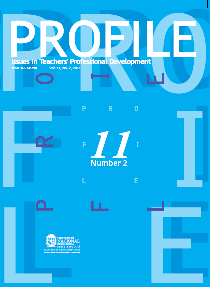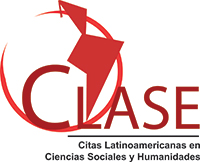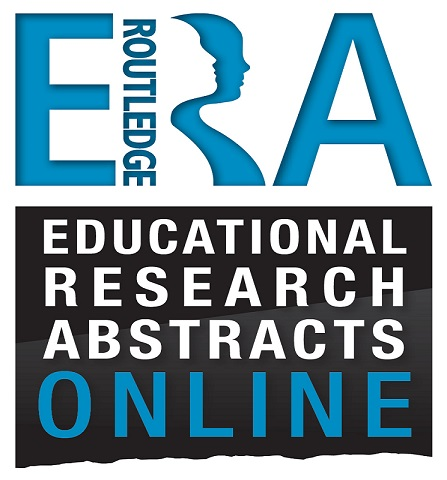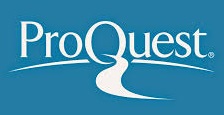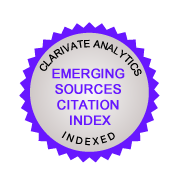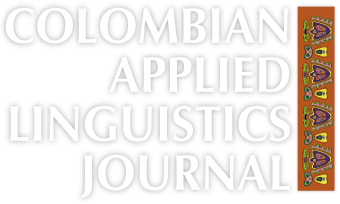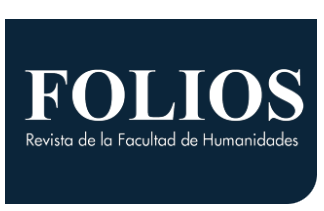Interaction in Online Tutoring Sessions: An Opportunity to Knit English Language Learning in a Blended Program
La interacción en las tutorías en línea: una oportunidad para tejer el aprendizaje de la lengua inglesa en un programa mixto
Keywords:
Interaction, online tutoring sessions, alex Virtual English Program, blended program (en)Interacción, tutorías en línea, Programa ALEX Virtual, programa mixto (es)
This article reports a research study which intended to describe the interaction taking place between a tutor and her students during the online tutoring sessions (OTS) in the ALEX Virtual English Program at the Universidad Nacional de Colombia, in Bogotá. Students' surveys, chat transcriptions and tutor's journals were used to collect data. The results showed how language itself, the methodology of the course, reflection upon learning, and social and personal issues made up the conversational topics prevailing in these sessions. It was also found that the main interactions between the tutor and the learners consisted of double-way dynamics.
Este artículo reporta un trabajo investigativo que buscó describir la interacción que tuvo lugar entre una tutora y sus estudiantes durante las tutorías en línea en el programa ALEX Virtual-Inglés de la Universidad Nacional de Colombia, en Bogotá. Para recolectar información se usaron encuestas a los estudiantes, transcripciones de chat y diarios de la tutora. Los resultados mostraron cómo la lengua en sí misma, la metodología del curso, la reflexión sobre el aprendizaje y los asuntos sociales y personales configuraban los temas de conversación predominantes en estas sesiones. También se encontró que las interacciones principales entre la tutora y los estudiantes consistían en dinámicas de doble vía.
Interaction in Online Tutoring Sessions: An Opportunity to Knit
English Language Learning in a Blended Program
La interacción en las tutorías en línea: una oportunidad para tejer
el aprendizaje de la lengua inglesa en un programa mixto
Rosa Alejandra Medina Riveros
Universidad Nacional de Colombia, sede Bogotá
ramedinar@unal.edu.co
Address: Carrera 33 No. 23-51, apto 307. Bogotá, Colombia.
This article was received on April 30, 2009 and accepted on August 9, 2009. This article reports a research study which intended to describe the interaction taking place between a
tutor and her students during the online tutoring sessions (ots ) in the alex Virtual English Program
at the Universidad Nacional de Colombia, in Bogotá. Students' surveys, chat transcriptions and tutor's
journals were used to collect data. The results showed how language itself, the methodology of the
course, reflection upon learning, and social and personal issues made up the conversational topics
prevailing in these sessions. It was also found that the main interactions between the tutor and the learners consisted of double-way dynamics.
Key words: Interaction, online tutoring sessions, alex Virtual English Program, blended program Este artículo reporta un trabajo investigativo que buscó describir la interacción que tuvo lugar entre
una tutora y sus estudiantes durante las tutorías en línea (tl ) en el programa alex Virtual-Inglés de
la Universidad Nacional de Colombia, en Bogotá. Para recolectar información se usaron encuestas
a los estudiantes, transcripciones de chat y diarios de la tutora. Los resultados mostraron cómo la
lengua en sí misma, la metodología del curso, la reflexión sobre el aprendizaje y los asuntos sociales
y personales configuraban los temas de conversación predominantes en estas sesiones. También se
encontró que las interacciones principales entre la tutora y los estudiantes consistían en dinámicas de doble vía.
Palabras clave: Interacción, tutorías en línea, Programa alex Virtual–Inglés, programa mixto Introduction The ways of teaching and learning have been
rapidly evolving due to the spread of technology over
the last few years. Learning management systems,
chats, discussion boards, multimedia applications,
blogs, wikis and social networks are new resources
for English teachers and learners. Incorporating
these technological tools into the learning environments
implies the development of innovative educational
programs. In Colombia, the Universidad
Nacional in Bogotá created the ALEX Virtual English
program, which mixes technological and faceto-
face components to help undergraduate students
develop their communicative competence. ALEX Virtual English is a modality of the
ALEX Program. ALEX, which stands for Programa
deDesarrollo del Aprendizaje Autónomo
de Lenguas Extranjeras, was created in 2001 with
the purpose of developing communicative competence
in a foreign language, emphasizing reading
comprehension through intensive pedagogy,
semi-autonomous learning and the use of new
educational technologies (Consejo Superior Universitario,
2001, Acuerdo 023). In 2007, six years after the ALEX Program
began, the University faced challenges such as
financial constraints, lack of space and heavy
demand of undergraduate students who needed
to fulfill the language-graduation requirement.
Hence, the Foreign Languages Department of
the Universidad Nacional and the Direction of
Academic and Virtual Services of the University,
(DNSAV) Dirección Nacional de Servicios Académicos
Virtuales de la Universidad Nacional de
Colombia, joined together to design virtual courses
for the language most in demand at the University:
English. This design resulted in the beginning of a
new modality of the ALEX Program. In addition
to the face-to-face courses, semi-virtual courses
were offered. As well as being an alternative for
the lack of space and the heavy demand of English,
the ALEX Virtual English courses represented an
opportunity to promote the use of the technological
resources the University had acquired; in this case,
the Blackboard learning management system. EFL teachers, tutors (pre-service teachers
from the last semesters of the Philology and
Languages-English Program) and undergraduate
students of the different majors of the university
were the main participants in the semi-virtual
courses. Discussion boards, e-mail writing, online
multimedia contents (modules), face-to face
meetings, exams, online and attending tutoring
sessions were the main elements of these courses. In such context, and while working as a tutor
of the ALEX Virtual program during the second
semester of 2008, I wondered how my students and
I would interact during the tutoring sessions. Both
attending and online sessions were unique learning
experiences, different from traditional classes.
These experiences portrayed a new kind of learning
in which tutor and students should create new
ways of interaction. Furthermore, interaction was a
defining characteristic of the ALEX Virtual modality
as based on the humanistic and pedagogical model
of constructivism and blended learning. ALEX Virtual was supported on two main
educational constructs: blended learning and
constructivism. Blended learning is a combination
of several pedagogies, tools and methods to create
efficient courses that give more responsibilities
to students. It is defined by Bliuc, Goodyear &
Ellis (2007) as the mix of traditional methods of
teaching, such as face-to-face teaching, and online
teaching. Another definition of this type of learning
is given by Graham (2006): "the combination of
the instruction from two historically separate
models of teaching and learning: traditional faceto-
face learning systems and distributed learning
systems with an emphasis on the role of computerbased
technologies" (p. 5). Moreover, the humanistic and pedagogical
model of constructivism states that knowledge is
built through social interaction and the knowledge
of language is not an exception to this premise. As
Vygotsky, quoted by Beaty (2002) claimed, social
interaction is the basis of language acquisition –for
the first language– and also in the case of foreign
languages learning. Therefore, interaction is the
mechanism by which language is spread. The interactional
hypothesis by Krashen (1977; 1982; 1985)
and Long (1985) as quoted by Barcárcel (2003) states
that the input received is transformed into meaningful
output through interaction. Furthermore,
Levy & Stockwell (2006) affirm that one of the consequences
of constructivism in computer mediated
education deals with the fact that "learning occurs
within a social context, and interaction between
learners and their peers is a necessary part of the
learning process" (p. 123). Without interaction, language
acquisition and learning are impossible. Due to the relevance of interaction as an
inherent component of knowledge construction
in innovative environments, this paper aims at
describing the interaction taking place between the
tutor and her learners in the online tutoring sessions
in two courses of ALEX Virtual during the second
semester of 2008. In order to achieve the aim of the
study, these research questions were posed:
Research Setting
The study was conducted at the Universidad Nacional de Colombia in Bogotá during the piloting stage of the ALEX Virtual English program in the second semester of 2008. In this period, the University was affected by closures and riots due to some students' discomfort towards the implementation of a new academic reform. The piloting stage of the ALEX Virtual Program was held in the first and second semesters of 2008. It was conceived as the fourth stage of the project of design of semi-virtual courses. The previous stages of this project were analysis, initial evaluation for planning, drafting, and designing (Rodríguez, Cárdenas & Aldana, 2008).
Participants
Students
Those who attended the online tutoring sessions during the second semester of 2008, were students of English of the ALEX Virtual level IV groups 1 and 2. Most of them were between 18 and 25 years old. They came from different undergraduate programs such as engineering, medicine, human sciences, agronomy, sciences and economics. They were finishing their undergraduate programs and some of them were working either at the University or at companies. Regarding language proficiency, these students were at an intermediate level. They were supposed to use all the simple and compound verbal tenses; however, they sometimes made a few grammatical and spelling mistakes that were noticeable in their written participations.
Tutor
I played the role of the tutor and thus, I was a participant-observer. This is my profile: A 20 year-old and 8th semester student of Philology and Languages-English, with previous experience working at ALEX as an auxiliary student in the attending courses and then as tutor in the virtual courses, level I and IV in the second term of 2008.
Theoretical Framework
The ALEX Virtual English Program
The program objectives and methodology were based on the principles of the ALEX Program and were presented to the university community in December 2007. The objectives of the program are to create new spaces for English language learning and to promote awareness of autonomous learning, strategies for a culture of autonomy and the use of virtual resources to support English language learning (Departamento de Lenguas Extranjeras, 2007).
Projects, academic and cultural meetings, work at the Resources Center and work within the virtual environment are the main components of ALEX Virtual methodology. They are described in more detailed as follows:
- Projects. Students have the possibility of finding out and analyzing information in the foreign language so they can gather knowledge about either the culture or their discipline in the foreign language. This helps students to develop collaborative work, practical knowledge and language skills.
- Cultural and academic meetings. These meetings include academic, cultural or recreational activities related to the foreign culture, the Colombian culture or different academic disciplines. These activities help students reflect upon the relationships among cultures and disciplines. They can also participate in online meetings through video chat at the cultural and academic meetings, English learning clubs, and special lectures.
- Work at the Resources Center. Access to the virtual courses and tutoring are the main goals intended there. Traditional resources such as books, videos, and audio material are also kept there for students' independent or assisted study.
- Work within the virtual environment. This is the main novelty of the program. It consists of the tools given by the learning management system Blackboard-online course, discussion boards, online assessment, e-mail, etc. and other tools developed at the Universidad Nacional video chat application for online tutoring (Departamento de Lenguas Extranjeras, 2007).
Tutoring
The Cambridge Dictionary of American English (2005) defines the action of tutoring as "to teach by working with one student or a small group, especially because they need special help". This definition provides some essential elements to build up a concept of tutoring such as working, teaching, student and a vague reference to a certain special help required by the student or a group of students.
However, these elements are not enough to shape a complete concept of tutoring. Correa (2004) provides other elements such as orientation and human relationship to enrich this concept. For him, tutoring consists of "a guidance service for students made by specialized teachers" (Correa, 2004, p. 45). He also points out the importance of tutoring as an educational process in which the main media are human relationships and interaction between personalities in a spontaneous and educational environment. For this reason, tutoring involves an individualized or group relationship with the students, structure and dynamics of their attitudes, aptitudes, knowledge, experiences in several educational environments, and "collaboration" to sum up both academic experience and daily life (Correa, 2004, p. 45).
Another definition of tutoring given by Mechén (1999) shows the importance of tutoring, not just as a teaching process alone, but as a teaching-learning process. The tutoring function is a complex process of teaching-learning in which the student must discover reality and culture. The significance in students' evolution is not the final result but the way, care and quality of several interventions during the process. This process creates a relationship between teacher and learner, in which not only students learn, but teachers gain knowledge of this process too.
According to these definitions, a concept of tutoring deals with these basic elements:
- ) Tutoring is an inherent activity of tutors.
- ) It implies a relationship between tutor and learners.
- ) It is a teaching-learning process.
Interaction
Malamah-Thomas (1987) defines interaction by pointing out its differences between classroom action and reaction. Classroom action deals with the lesson plan and objectives given by the teacher. This action provokes a reaction in students shown in the learning results which, in turn, causes a new action by the teacher and so on. The process occurs as shown in the following figure.
However, Malamah-Thomas (1987) also explains that interaction is more than action after reaction. Thus "interaction means acting reciprocally, acting upon each other" (p. 46). The teacher acts upon students; they act upon the teacher, modifying his/her behavior and so on. In this case, "there is a constant pattern of mutual influence and adjustment" (Ibid.).
Online Tutoring at alex Virtual
The video chat developed at the University was intended to enable visual and spoken synchronic communication (Tovar & Ruiz, 2006). However, the students did not use a camera or microphone very often because they did not have it or because the system did not work efficiently for voice transmission. The communication was mainly written. The number of students participating in the OTS varied from 3 to 10 participants per session. Students accessed the video chat from their homes or from "internet cafes" on Wednesdays and Thursdays from 8:00 to 9:00 pm.
Research Methodology
This research was a participant-observational case study. Merriam (1988) defines a case study as a bounded system limited by physical and concrete boundaries. In this specific study, the physical boundaries were the online tutoring sessions of ALEX Virtual Level IV groups 1 and 2 during the second semester 2008. The concrete boundary was the construct of verbal, written and online interaction.
According to the role of the researcher, this case study followed a participant observational approach. In this study, the researcher played the role not only of tutor while participating in the online tutoring sessions, but also of observer. This approach also allowed the researcher to "develop a more intimate and informal relationship with those who are being observed and provide a superior grade of naturalness to the data gathering" (Cohen, Manion & Morrison, 2000, p. 188).
Regarding the research procedure, five stages were established to develop this study: unstructured participant observation and open gathering of data; identification of the phenomenon to be studied and research questions; selection and application of data collection instruments; data analysis and interpretation, and report writing. The process of data analysis for this investigation consisted of the following techniques: open and axial coding, and triangulation of instruments (Neuman, 1997).
The following instruments provided the data for the study of interaction: chat transcripts, tutor journals, and students' surveys. The transcript of six tutoring sessions were collected and analyzed to find the actions and reactions noticeable in the video chat. The extracts were not modified and were copied and pasted from the beginning to the end of the session in order to be analyzed later on. In addition, the names of the students were changed in the report to protect their identity.
The tutor's journals were collected after every session. They gathered records of actions that occurred during the tutoring sessions and some of the tutor's reflections upon the process that occurred in the video-chat. The survey was carried out through a questionnaire which included open and closed items. Open-ended questions helped us elicit information about students' perceptions and commentaries on the procedure and activities done during the tutoring sessions. Closed items were used in order to corroborate a range of categories emerging from the other two instruments. The specific question type here was frequency ranking. Closed questions provided information about what the students did during the online tutoring they have attended, as well as their opinions about the activities they had participated in.
Findings
Interaction during the online tutoring sessions is like knitting. At first there must be enough wool to start knitting. The wool can be in yarns of diverse colors that will provide the shades of the final tissue. The sources for the knitting of interaction in the OTS were four conversational topics that were common for all the sessions. Methodology of the course, personal and social issues, language itself and reflection upon language learning made up the wool for the knitting.
However, wool alone cannot become the tissue of language learning. Hence, the intervention of needles is necessary for the process. The needles are the main actors of the process of learning construction. In the case of OTS at ALEX Virtual, both students and tutor were the needles of the knitting process. It is due to teamwork that the tissue of language learning was created.
Nevertheless, having wool and needles are not enough to knit. Movement and interaction between the needles and the wool are required to transform wool into tissue. These interactions between students and tutor along with topics are like stitches of the knitting project. Knitting the language for learning purposes is not a simple process. Needles and wool must interact stitch by stitch. These stitches are the students' and tutor's interactions which create a special macro stitch between the participants and the topics. This is the learning event, as described by Malamah-Thomas (1987).
Interaction in the OTS at ALEX Virtual is the knitting of students' and tutor's actions to construct the tissue of language learning. The wool yarns are the sources for the knitting. The needles are the students and the tutor. The stitches are the students' and tutor's interactions during the online tutoring session. These elements together make up the tissue of language learning through the complex process of interaction, as shown in Figure 2.
Four Wool Yarns: Conversational Topics as Sources of Interaction
The first thing to do when knitting is to look for the materials for the project, the wool. The wool yarn for the knitting is the conversational topics of the online tutoring sessions. According to Coulthard (1985), a conversational topic is a "tellable event". Tellability or newsworththiness is related to "Why now and why to me" (p. 79). In other words, tellability is the relevance of a certain event for everyone or for a restricted audience –students and tutor in this case. The importance of a certain event for a certain audience defines whether this is or not a topic.
In this study, the journal, the transcripts and the open-ended questions in the survey showed four main conversational topics that served as sources of the interaction during the online tutoring sessions. These conversational topics are language itself, the methodology of the course, reflection upon language learning and personal and social issues.
The four topics described above were not perceived as equally frequent in the OTS. In the stuof language learning through the complex process of interaction, as shown in Figure 2. dents' survey carried out in this study, the students were asked to identify the most frequent topics during the online tutoring. They chose, first and foremost, language itself; followed by methodology of the course (organization and technical constraints) and then reflection upon language learning. The least frequent conversational topic, from the students' point of view, was personal and social issues.
Students could select more than one checkbox in the survey, so percentages added up to more than 100%, as we can see in Table 1
These results show that the students perceived the online tutoring sessions as environments in which the main source of conversation was language itself. Students at the fourth level of ALEX Virtual thought that they spent much time in the online tutoring sessions talking about linguistic topics. Students used to talk about grammar, reading, writing, etc. The second most frequent topic of conversation had to do with the methodology of the course. This topic was more recurrent because the students and the tutor took advantage of the OTS to clarify the activities of the week and to organize the Academic and Cultural Meetings. Even though students had other resources of study and communication such as discussion boards and e-mail, they preferred the synchronous communication in the OTS to solve their most relevant doubts regarding language form and organization of the course.
The least frequently chosen, Reflection upon language learning and Personal and social issues, illustrated that students seem to overlook the importance of learning awareness, intersubjectivity and context when studying a language. These findings could evidence a different point of view about how to learn, since the students' results show that learning a language seems to be a matter of acquisition of linguistic knowledge and organization rather than an intersubjective, reflective process, as proposed by the communicative approach.
Language Itself
References to language itself, grammar, vocabulary and reading were very frequent among the participants of this investigation. The students were particularly concerned about their language accuracy regarding grammar and vocabulary. This was also influenced by the grammatical contents of the modules of study like conditionals and wish clauses. This category is related to Halliday's textual function. As the author claimed, "the textual function is not limited to the establishment of relations between sentences; it is concerned just as much with the internal organization of the sentence, with its meaning as a message both in itself and in relation to the context" (Halliday, 1973, p. 107).
The following are statements taken from the answers to the question, What do you do in the OTS?
In the two sessions in which I had participated I solve questions about grammar. I felt Ok. (Camila. SR, 3).
[...] we talked about topics of the week, as wishes and enquiry concepts. To Review these topics each classmate gave an example of the topic related to their life, the tutor was a guide and she corrects us [...]
The topic we were talking about was Wishes. We made some exercises about the topic. I talked with my classmates using the the online chat. I started the tutoring and the teacher explained me the topic and I start to participate in this activity. I felt fine. (Paola SR, 21)
First I say hello to the tutor, then I told her about some doubts that I had, than she answered me, then we practice for the exam. We practice some of wishes and conditionals, finally I say bye bye, and that's all. (Juan SR, 26)
As can be read in the samples provided, most of them related to grammar contents of the modules of ALEX level IV. For example: conditionals and wish clauses. Another topic had to do with the reading concepts studied in the reading section of the modules, in this case how to identify elements of enquiry texts.
Methodology of the Course
This wool yarn is composed of questions and explanations about the methodology of the course. The use of the Blackboard platform, the activities of the week, the organization of the cultural meetings and other technical problems made up this topic. Students considered they were the ones who asked more about this topic in the online tutoring sessions. Asking the tutor about the procedures of the course seems to be the most frequent students' activity in the OTS, as shown in Figure 3
These results may indicate the relevance of course methodology in blended learning programs like ALEX Virtual. In the online tutoring sessions, students focused on gathering clear and complete information about the tasks they had to develop throughout the course, even when they had other communication tools such as internal e-mail, platform announcements and discussion boards. Methodological issues were taken into account in the students' answer to the question: What do you do in the online tutoring sessions? This can be seen in the following excerpt1:
In the last session we speak about the second exam, about the doubts that we had, also we speak about the cultural meeting, the groups, the topic, the date, the hour and the activities that we must do for it.
(Jose, SR, 7)
The methodology then must be comprehensible for the students and the tutor to work on the other topics of the course: language, learning and personal or social issues.
Reflection upon Language Learning
Learning how to learn, learning strategies, extra sources and reflection upon language are contained here. These aspects have been traditionally associated with metacognitive awareness. According to Ellis (2000), metacognitive awareness includes the following strands: "language awareness, cognitive awareness, social awareness and cultural awareness. These overlap in class self-awareness and self confidence" (p. 75).
Positive attitudes, values and beliefs provide a solid and positive foundation for the future and contribute to the motivation to learn, as well as to the realization of the students' ability to learn. Traces of metacognitive awareness and, more specifically, reflection upon language learning can be identified in these samples:
[...] J. said: "I'm agree" and I explained to him that " to agree" is a verb like any other action verb, so it wasn't necessary to use "to be " there. OK "sorry" said him. I told him not to worry or to be afraid of making mistakes, anyway it was good for him to make mistakes, but it was better if he identifies them and corrects them. He must not apologize for his mistakes but he must recognize them, understand why certain structures are not accurate and study more to get over his difficulties.
(Tutor's journal, November 12th 2008)
In this journal fragment, the tutor encouraged the students to reflect upon their fear of making mistakes, and expresses her point of view about errors. These are seen as normal elements of the learning process, which must be identified and corrected, but not reasons to apologize.
There was also a reflection upon new learning strategies. Students asked about extra sources apart from the ones proposed in the course. They were more aware of their needs and asked for help, as showed in this example:
My tutor recommended me some pages to practice and improve my English and actually I feel great because it's a very good space and the tutor is very helpful.
(Anderson, SR, 23)
In the next transcript, students were asked to use wish clauses to express regrets and the tutor emphasizes the importance of the authentic use of language:
Tutor: so, John your regret is missing
John: I'm in white
John: I wish I hadn't been in that concert
Tutor: which concert?
Tutor: good example
John: whatever
John: is a lie
Tutor: I was asking for real regrets
Tutor: because, when you learn a language it's for real
communication
John: but I can't remember any regret
John: from my life
Amy: he is perfect he had not regreats jaja
John: yes
John: exactly jejeje
Harold: that is so good!!
Tutor: I wish he remembered his regrets
Tutor: ok, good
John: i'm not perfect but I have a good life(Online tutoring session, December 4, 2008)
Personal and Social Issues
This category corresponds to the interpersonal function coined by Halliday (1973). This function occurs when "the speaker is using language as the means of his own intrusion into the speech event: the expression of his comments, his attitudes and evaluations, and also the relationship that someone sets up between himself and the listener" (Halliday, 1973, p. 106). Although the students perceived this as the least frequent aspect they talked about in the tutoring sessions, there is evidence of tutor's references to social or personal issues as icebreakers of the conversation.
Short talks about social or current issues of the University were presented as ice-breakers or before leaving the tutoring. The University was one of the social topics discussed on the session. Punctuation, exclamation marks, laugh, emoticons and jokes were used to fulfill the interpersonal function.
The context of the OTS provided opportunities to talk about socio-cultural topics at the University such as strikes, closures, riots or social events. In this example, the tutor and the students discuss the strikes at the University, which led to the closure of the campus for several days.
Tutor: what do you think of the situation at the
university?
Nancy: normal
María P: terrible
María P: !!!!
Tutor: they said we're not having classes
María P: yes I know
Sussy: why?
Tutor: but remember we go on with Alex
Tutor: today there were riots on the 262
Tutor: ALEX VIRTUAL never stops
Nancy: riots??? jajaja" bonche?"3
Harold: yes
Tutor: yeahp, so we continue working
María P: pedrea
María P: ok
Nancy: don't worry tutor we never stop too jejeje(Online tutoring session, October 23, 2008)
In the OTS, students were also able to express how they felt during the course. The tutor could understand the students' feelings and together the students and the tutor looked for strategies to improve the learning experience. Sometimes humor was incorporated when talking about these issues. This phenomenon has also been studied by Darhower (2002).
The author highlights the importance of intersubjectivity and sociocultural theory in a similar context of synchronous online written interaction medium as the chat. Intersubjectivity is defined as "the establishment of a shared perspective between an expert and a learner in a problem-solving task" (Darhower, 2002, p. 253). In the following fragment of a conversation, two students and the tutor negotiated a perspective about the final exam.
John: I'm scered for the exam
John: scared
Harold: jeje
Tutor: you too Harold?
Harold: so so
John: I don't remember anything
John: I'm forget all
Harold: because I cant lose it
Tutor: oh oh, mm
Tutor: *fail an exam
Harold: fail
Harold: O
John: I'm have clean my mine
Harold: jajaja
Tutor: jiji, do you suffer from amnesia?
John: yes
Tutor: great, this always happens before exams, let's
find a solution(Online tutoring session, December 3, 2008)
As can be read in the conversation, the students were expressing their fears of taking the final exam. The students and the tutor made jokes about the students' amnesia before the test. At the end, the tutor encouraged them to find a strategy to enhance students' confidence in what they had learned. In a traditional class, this close communication of feelings and social issues between students and teacher rarely appears and, if it does, it is overlooked.
Stitch by Stitch: Tutor and Students' Conversational Interactions
In the OTS, interactions appeared as two-way processes: greeting and leave taking, asking and answering, explaining and exemplifying, praising and repairing.
Greeting and leave taking are the framework interactions of the learning event. In these interactions students tended to use informal ways of greeting and leave taking. However, such forms were generally very basic. For instance, learners may produce greetings and leave takings like "hello" and "bye" instead of more complex structures : "How have you been?", "Talk to you later", etc. Also, students may use emoticons and jokes as ice-breakers. This simplification of the language seems to appear to be placing emphasis on the phatic function of language to create the necessary intersubjectivity among the participants before dealing with the new teaching points.
In the asking- answering dynamic, many possibilities are offered. For instance, the tutor asked the students if they had doubts regarding specific contents such as reading or grammar. The tutor asked the students to give examples or explanations to their classmates or the students asked for information about language itself or the course methodology (cultural event, progress exam, etc.).
Another type of interaction occurred when the tutor and the students explained and exemplified. Most of the time, the tutor explained the language or the methodology. Students also gave examples and explanations. The students' feedback was necessary to complement the explanation and verify their understanding. This is seen in the following example when the students and the tutor kept asking, answering, exemplifying and explaining noun phrases:
David: I have a question
I don't understand very well the difference
between noun phrase and sentence [Question]
Tutor: for example you have a sentence like this:
David who is studying at ALEX Virtual doesn't
have to buy expensive English books.
[Example]
Tutor: This is my sentence and here you have 1 sentence and two noun phrases [...]
Tutor: a sentence is composed by subject, verb and complement
Tutor: while a noun phrase is made up by a noun and other words that modify the word
David: the noun phrase is like a topic
David: yes? [Question]
Tutor: This is a noun phrase: David, who is studying at ALEX Virtual [Example]
Tutor: Noun phrases are very used in titles [...] topics, events, titles of researches etc, are usually expressed through noun phrases
[Explanation]
David: ok
lore___-_01: I need other example
Tutor: what was the title of the last book you've read?
[Question]
Esmeralda Alvarez: essay about blindness [Example]
John_Carlos_Almeciga,_Group_2: the election
lore___-_01: Language Disorders in Children: An Evidence-Based Approach to Assessment andTreatment. [Example]
Tutor: you have a main word and modifiers of that word [Explanation]
Tutor: digo, what was your book? [Question]
David: the metamorphosis [Example] esmeraldaalvarez: hey!!! David??
Tutor: a very good book |
Tutor: "the metamorphosis" is not a sentence
Tutor: that's a noun phrase [Explanation](Online tutoring session October 24)
Praise deals with positive feedback which may consist of repeating the correct answer, or expressing a comment such as "great", "perfect", "well done", etc. This interaction is mainly performed by the tutor to reinforce students' motivation, confirm their understanding and enhance self awareness of learning. In the example above the tutor praised a student's answer in the sentence "a very good book".
Finally, one of the most complex types of interactions was error repairing or noticing. Chapelle (1998) states that by noticing, "learners internalize new forms and improve the accuracy of their existing grammatical knowledge" (p. 24). She also affirms that "the process of noticing can occur through learners' own reflection and monitoring or through triggers provided by others" (Chapelle, 1998, p. 24). There were three ways in which students noticed their linguistic problems in the OTS: tutor's repairing, peer repairing and self repairing.
Tutor's Repairing
Most of the students considered this as very frequent interaction in the OTS. There were two main ways of tutor's repairing: direct and indirect correction. Sometimes the correction of the mistake had a negative feedback expressed through a joke. In this case, the tutor's comment made the student notice his problem.
J. 02: what we can to do to use the reactive power and have a better power factor
(Online tutoring session October 23)
David: what?
esmeraldaalvarez: *what can we
J 02: ohh yes... jeje I am sorry
Tutor: can is a modal, so can to is wrong
Tutor: and please, for God's sake don't put "can to" in your exams your teachers will cry next time
Also, the tutor sometimes looked for ways of indirect repairing. In this example, the tutor wanted the other students to repair Amy's errors.
Amy: I wish I had travelling around the world
(Online tutoring session December, 2008)
Tutor: ok, let's analyze these sentences
Tutor: help me to find the errors there
Harold: I wish I had travel around the world
Self Repairing
According to the survey, most of the students (70%) thought they sometimes, very frequently or almost always repaired their errors in the OTS. This occurred due to the nature of written communication. In this type of communication, students become more aware of their mistakes since they have more time to think about what and how to say something than in oral communication. This is an example of self repairing. In this case, the misspelling may change the meaning of the sentence:
Jose: ok.... Tutor one question; know our cultural meeting will be also with the other levels?
Jose: *now(Online Tutoring Session, November 21, 2008)
Peer Correction
Peer correction was not perceived as a very frequent activity in the OTS. Though 40% of the students expressed that they never or almost never corrected their peers, transcript evidence shows how it occurred. In the following example, Harold corrected John's sentence, "I wish I would pass the exam" to express a wish in the present. Harold provided a correction and the tutor confirmed it.
Tutor: let's see John's example: I wish I would pass the exam
Tutor: John, is that a wish, a regret or something annoying?
Tutor: what's that?
Harold: I think this is a wish
Tutor: yes, it is
Harold: I wish I passed the exam
Tutor: yes, it is(Online Tutoring Session, December 2008)
Knitting interaction in the OTS was composed of several stitches. These stitches or interactions were two-way processes which involved the tutor and the students: greeting and leave taking, asking and answering, explaining and exemplifying, praising and repairing. From these stitches, repairing is a very complex interaction which includes tutor, peer, and self repairing.
Two Needles: The Students and the Tutor
Knitting interaction in the OTS is a human process which requires two needles or actors who develop the topics of conversation (wool yarn of the knitting) through the performance of some interactions (stitches). These actors or needles are the students and the tutor.
The students are the main actors of the OTS. The session is based on the students' inquiries about language and course methodology. Besides, students can express their ideas, doubts and feelings about their learning process. They can also interact with peers and the tutor to discuss social or personal topics. The students' usual interactions consisted of asking, answering, exemplifying, joking, laughing and repairing. They almost never explained mistakes or praised their classmates. Students asked about the methodology of the course and the language mainly to gather new information. They also answered the tutor's verification questions about language as a follow-up move. Also, they used the OTS to talk more informally. Students told jokes and laughed, exchanged personal information (e-mails, mobile numbers, etc.). Finally, students corrected themselves and sometimes their peers, but they never corrected the tutor.
The tutor in the OTS is the learners' helper and the actor responsible for providing the guidelines of the course. Rather than a figure of authority, the tutor is an empathetic actor. Students felt free to express their feelings in the tutor's presence. The tutor's typical interactions in the OTS were asking, explaining, praising and repairing. The tutor asked students about personal or social issues to break the ice at the beginning of the conversation. Furthermore, the tutor formulated questions to verify the understanding of a methodological topic or a linguistic concept. The purpose of these types of questions was not to get new information but to receive students' feedback regarding a previous explanation. The tutor also asked the students to exemplify and explain to their peers. For instance, in indirect correction, the tutor might start by asking for an example before explaining the communicative function and structure of the statement. This is an inductive process from the instances to the generalizations. The tutor was also in charge of the reflection upon learning. Praising and repairing were also typical tutor's interactions.
Conclusions
The ALEX Virtual Program at the Universidad Nacional de Colombia provides environments for students to get familiar with technological tools and take advantage of them to study English as a foreign language. The online tutoring sessions are part of these technological tools. These spaces create opportunities for social and linguistic interaction between the tutor and the students. It is due to this social and linguistic interaction that students receive input and transform it into communicative output.
The interaction taking place during the online tutoring sessions at ALEX Virtual was studied from the perspective of the following questions: 1) What do the students and the tutor talk about in the online tutoring sessions? and 2) Which interactions are evidenced during the online tutoring sessions?
In response to the first question, What do the students and the tutor talk about in the OTS?, the students' survey, the tutor's journal and the chat transcripts showed that four topics composed the core of the talk. These topics were the language itself, the methodology of the course, learning, and personal and social issues.
The first topic, language itself, has to do with the participants' need to focus on the form of the foreign language. For example, students were more aware of linguistic mistakes than in a traditional class and received feedback about them. Grammar topics like the use of conditionals, gerunds and wish clauses were discussed in the OTS. The tutor and the students also worked on doubts about vocabulary and reading. These linguistic points correspond to the contents of the modules that make up the course. Language itself was the most frequent topic of the conversations according to the students' survey.
The second topic of conversation in the OTS was the methodology of the course. Chatting about organizational constraints fulfilled the students' need for clear information about what they had to do in the course. The main methodological issues discussed were the planning and organization of the cultural and academic meeting, the activities of the week and the exams. In general, we could observe that having a clear idea about the methodology of the course is a key issue for the development of the virtual course; it reinforces students' responsibility in their learning.
Learning was the third topic found in the conversations of the OTS. Despite the student's lack of awareness of their learning process, in the OTS students could get information about learning strategies and extra sources. Most of the time, the tutor was the one who reflected upon language learning. The function of mistakes in learning, the authenticity of language and extra sources for learning were the main issues discussed regarding learning. Hence, it is necessary for tutors and students to invest more time reflecting upon learning in order to identify their weaknesses and strengths.
Social and personal issues were the last topic of conversation discussed in the OTS. Students felt free to express their feelings about their process, which improved the relationship between the tutor and the students. Together, they could create strategies to solve problems. Social issues are also included in this category. The most prevalent social issue in the OTS was the University. In the second semester of 2008, several social events took place at the University such as strikes, riots, University closures and the indigenous meeting called "Minga" which became sources of conversation in the OTS.
Regarding the second question of this study, Which interactions are evidenced during the online tutoring sessions?, it was concluded that the main interactions that made up the learning event in the OTS were greeting and leave taking, asking and answering, explaining and exemplifying, praising and repairing. Greeting and leave taking were very informal interactions. Students and tutor use simple language and talk about personal and social issues as ice-breakers and wrap-ups. Asking and answering are the most common interactions. The students and the tutor asked and answered with different purposes. The students asked about language itself to solve their doubts about grammar or vocabulary while the tutor asked the students to confirm they had understood the topics. Other interactions used as strategies to solve doubts were explaining and exemplifying. The tutor was the person who explained more about language and methodology and both participants wrote examples about the topic discussed.
Praising and repairing were ways in which the tutor and the students provided feedback. Though the tutor was in charge of giving positive feedback to the students, both the tutor and the students provided negative feedback or repairing. Moreover, repairing was a typical feature of the online conversations because of the written nature of the chat. This kind of interaction improved the quality of the output produced by the students through constant feedback.
The current study showed that in the online tutoring sessions, interactions taking place between the tutor and the students are slightly different from those of traditional classes. Although the tutor and the students did not have a lesson plan, they found other ways to study the language.
Limitations and Further Research
The context of the university and the use of the video-chat tool were the most relevant limitations of this study.
Strikes and University closures did not allow students to participate with the same frequency in the OTS. It also affected the topics of conversation during the online tutoring. For this reason, the students participated in the online tutoring sessions mainly to know what to do (methodological constraints) and to discuss the situation at the University. Some of the students did not have the required tools for the tutoring session such as a camera or a microphone, making the communication mainly type-based. Other results could have appeared if students would have used microphones and cameras. In that case, this research could have gathered extra features, besides the written chat. Such features would have included pronunciation, turn taking and silence, which were not observable in the written interaction.
The current study has implications regarding the study of the Information and Communication Technology (ICT) area in Colombia, the development of the ALEX Virtual program and the interaction in the OTS in future courses. It is necessary to strengthen and support research initiatives on ICT applied to education in developing countries like Colombia to improve students' and teacher's abilities to access knowledge. There should be more programs like ALEX Virtual in other institutions with similar characteristics. With respect to the OTS, students and teachers/tutors from other EFL programs can implement OTS in their courses to interact around language itself, methodology, learning, and personal and social issues enhancing their learning experience.
For further research it may be fruitful to study interaction in other courses where other variables such as the use of Spanish could appear. Future tutors and students of ALEX must take advantage of the online tutoring sessions to raise their awareness about language learning. A better understanding of how students learn would imply a better understanding of students' strengths and weaknesses.
More detailed studies on ICT applied to EFL will improve the quality and the quantity of opportunities for Colombian students and tutors/ teachers to learn and teach using technology. In addition, more research about the ALEX Virtual English Program will contribute to a better implementation of the program at the University and its replication in other institutions. Finally, studying in depth the interaction between students and tutors in the OTS will imply a better use of this toolin EFL contexts.
1 Samples included hereafter have not been edited. They are presented as produced by the participants, who are identified with initials or pseudonyms.
2 The 26th Street is a road fronting a side of the University campus. Note from the Editor.
3 "Bonche" is a colloquial Spanish word Colombian students use to name a riot or a fight. Note from the Editor.
References
Balcárcel, G. (2003).Teacher talk at three Colombian higher education institutions. PROFILE Issues in Teachers' Professional Development, 4, 9-14.
Beaty, K. (2002). Teaching and researching computer language learning. Cambridge: Cambridge University Press.
Bliuc, A.-M., Goodyear P., & Ellis, R. (2007). Research focus and methodological choices in studies into students' experiences of blended learning in higher education. Internet and Higher Education, 10, 231-244. doi:10.1016/j.iheduc.2007.08.001
Cambridge Dictionary of American English. (2005). Tutor definition. Retrieved on August 9, 2008 from Web site: http://dictionary.cambridge.org/define.asp?key=tutor*1+0& dict=A
Chapelle, C. (1998). Multimedia CALL: Lessons to be learned from research on instructed SLA . Language Learning & Technology. 2(1), 22-34. Retrieved on May 8, 2008 from Web site: http://llt.msu.edu/vol2num1/pdf/article1.pdf
Cohen, L, Manion L., & Morrison K. (2000). Research methods in education. London: Routledge Falmer.
Colombia. Universidad Nacional de Colombia [UN]. (2001). Reglamentación en el proceso de institucionalización del Programa ALEX. Acuerdo 023 de 2001 (Acta 10 de diciembre de 2001). Bogotá: Consejo Superior Universitario.
Correa, C. (2004). La universidad y la educación a distancia. Santa Marta: Universidad del Magdalena.
Coulthard, M. (1985). An introduction to discourse analysis. New York: Longman.
Darhower, M. (2002). Instructional features of synchronous computer-mediated communication in the intermediate L2 class: A sociocultural case study. CALICO Journal, 19,249-277 Retrieved on March 27, 2009, from Web site: https://www.calico.org/html/article_426.pdf
Departamento de Lenguas Extranjeras (2007). Folleto divulgativo lanzamiento, ALEX Virtual. Bogotá: Universidad Nacional de Colombia.
Graham, C. (2006). Blended learning systems. Definitions, current trends and future directions. In: C. J. Bonk, & C. R. Graham, (Eds.), The handbook of blended learning: Global perspectives, local designs. San Francisco: Pfeiffer.
Ellis, G. (2000). Is it worth it? Convincing teachers of the value of developing metacognitive awareness in children. In: Sinclair B, McGrath I., & Lamb, T. (Eds.). Learner Autonomy, Teacher Autonomy: Future Directions. London: Longman.
Halliday, M. A.K. (1973). Explorations in the functions of language. London: Edward Arnold Publishers.
Levy, M., & G. Stockwell. (2006). CALL dimensions: Options and issues in Computer-Assisted Language Learning. New Jersey: Mike Lawrence Erlbaum Associates Inc.
Malamah-Thomas, A. (1987). Classroom interaction. A scheme for teacher education. Oxford: Oxford University Press.
Mechén, F. (1999). El tutor. Dimensión histórica, social y educativa. Madrid: Editorial CSS.
Merriam, S. B. (1988). Case study research in education. A qualitative approach. California: Jossey-Bass.
Neuman, W. (1997). Social research methods. Qualitative and quantitative approaches. Needham Heights, Boston: Allyn & Bacon.
Rodríguez, M., Cárdenas M. L., & Aldana, C. (2008). The Design of Alex Virtual Courses: Challenges and Implications for ELT . Plenary Session 8 at ASCOPI Conference, Tunja 2008. [Power Point Slides].
Tovar, J., & Ruiz, L. (2006). Implementación de un espacio colaborativo virtual de aprendizaje. Retrieved on May 20, 2008 from Web site: http://www.virtual.unal.edu.co/unvPortal/articles/ArticlesViewer.do?reqCode=viewDetails& idArticle=3
About the Authors
Rosa Alejandra Medina Riveros holds a B.A. in Philology and Languages from Universidad
Nacional de Colombia, sede Bogotá. She participated as an auxiliary student in the alex program
and then as tutor in the virtual modality of the same program. This article reports on her monograph project as a graduation requirement at the same university.
References
Balcárcel, G. (2003).Teacher talk at three Colombian higher education institutions. Profiel: Issues in Teachers' Professional Development, 4, 9-14.
Beaty, K. (2002). Teaching and researching computer language learning. Cambridge: Cambridge University Press.
Bliuc, A.-M., Goodyear P., & Ellis, R. (2007). Research focus and methodological choices in studies into students' experiences of blended learning in higher education. Internet and Higher Education, 10, 231-244. doi:10.1016/j.iheduc.2007.08.001
Cambridge Dictionary of American English. (2005). Tutor definition. Retrieved on August 9, 2008 from http://dictionary.cambridge.org/define.asp?key=tutor*1+0& dict=A
Chapelle, C. (1998). Multimedia CALL: Lessons to be learned from research on instructed SLA . Language Learning & Technology. 2(1), 22-34. Retrieved on May 8, 2008 from http://llt.msu.edu/vol2num1/pdf/article1.pdf
Cohen, L, Manion L., & Morrison K. (2000). Research methods in education. London: Routledge Falmer.
Colombia. Universidad Nacional de Colombia [UN]. (2001). Reglamentación en el proceso de institucionalización del Programa ALEX. Acuerdo 023 de 2001 (Acta 10 de diciembre de 2001). Bogotá: Consejo Superior Universitario.
Correa, C. (2004). La universidad y la educación a distancia. Santa Marta: Universidad del Magdalena.
Coulthard, M. (1985). An introduction to discourse analysis. New York: Longman.
Darhower, M. (2002). Instructional features of synchronous computer-mediated communication in the intermediate L2 class: A sociocultural case study. CALICO Journal, 19,249-277 Retrieved on March 27, 2009, from https://www.calico.org/html/article_426.pdf
Departamento de Lenguas Extranjeras (2007). Folleto divulgativo lanzamiento, ALEX Virtual. Bogotá: Universidad Nacional de Colombia.
Graham, C. (2006). Blended learning systems. Definitions, current trends and future directions. In: C. J. Bonk, & C. R. Graham, (Eds.), The handbook of blended learning: Global perspectives, local designs. San Francisco: Pfeiffer.
Ellis, G. (2000). Is it worth it? Convincing teachers of the value of developing metacognitive awareness in children. In: Sinclair B, McGrath I., & Lamb, T. (Eds.). Learner Autonomy, Teacher Autonomy: Future Directions. London: Longman.
Halliday, M. A.K. (1973). Explorations in the functions of language. London: Edward Arnold Publishers.
Levy, M., & G. Stockwell. (2006). CALL dimensions: Options and issues in Computer-Assisted Language Learning. New Jersey: Mike Lawrence Erlbaum Associates Inc.
Malamah-Thomas, A. (1987). Classroom interaction. A scheme for teacher education. Oxford: Oxford University Press.
Mechén, F. (1999). El tutor. Dimensión histórica, social y educativa. Madrid: Editorial CSS.
Merriam, S. B. (1988). Case study research in education. A qualitative approach. California: Jossey-Bass.
Neuman, W. (1997). Social research methods. Qualitative and quantitative approaches. Needham Heights, Boston: Allyn & Bacon.
Rodríguez, M., Cárdenas M. L., & Aldana, C. (2008). The Design of Alex Virtual Courses: Challenges and Implications for ELT . Plenary Session 8 at ASCOPI Conference, Tunja 2008. [Power Point Slides].
Tovar, J., & Ruiz, L. (2006). Implementación de un espacio colaborativo virtual de aprendizaje. Retrieved on May 20, 2008 from http://www.virtual.unal.edu.co/unvPortal/articles/ArticlesViewer.do?reqCode=viewDetails& idArticle=3
How to Cite
APA
ACM
ACS
ABNT
Chicago
Harvard
IEEE
MLA
Turabian
Vancouver
Download Citation
Article abstract page views
Downloads
License
Copyright (c) 2009 Rosa Alejandra Medina Riveros

This work is licensed under a Creative Commons Attribution-NonCommercial-NoDerivatives 4.0 International License.
You are authorized to copy and redistribute the material in any medium or format as long as you give appropriate credit to the authors of the articles and to Profile: Issues in Teachers' Professional Development as original source of publication. The use of the material for commercial purposes is not allowed. If you remix, transform, or build upon the material, you may not distribute the modified material.
Authors retain the intellectual property of their manuscripts with the following restriction: first publication is granted to Profile: Issues in Teachers' Professional Development.



